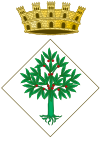Lloret de Mar
| Lloret de Mar | |||
|---|---|---|---|
| Municipality | |||
 |
|||
|
|||
| Nickname(s): Lloret | |||
| Location in Catalonia | |||
| Coordinates: 41°42′N 2°50′E / 41.700°N 2.833°ECoordinates: 41°42′N 2°50′E / 41.700°N 2.833°E | |||
| Country |
|
||
| Autonomous Community |
|
||
| Province | Girona | ||
| Comarca | Selva | ||
| Government | |||
| • Mayor | Jaume Dulsat Rodríguez (2015) | ||
| Area | |||
| • Total | 48.7 km2 (18.8 sq mi) | ||
| Elevation | 5 m (16 ft) | ||
| Population (2014) | |||
| • Total | 38,624 | ||
| • Density | 790/km2 (2,100/sq mi) | ||
| Demonym(s) | Lloretenc, lloretenca | ||
| Website | lloret |
||
Lloret de Mar (Catalan: [ʎuˈɾɛd də ˈmar], Spanish: [ʎoˈɾe(ð) ðe ˈmar]) is a Mediterranean coastal town in Catalonia, Spain. One of the most popular holiday resorts on the Costa Brava, it is 40 kilometres (25 miles) south of Girona and 75 kilometres (47 miles) northeast of Barcelona. With a population of 39,363 in 2009, it is the second largest town in the Selva comarca of Catalonia.
Lloret de Mar attracts summer visitors on package tours. Its main beach (length: 1,630 m; width: 45 m; small, gravel-like stones) is one of the most popular Costa Brava beaches and is consistently awarded the Blue Flag for cleanliness.
The town of Lloret de Mar covers 48.9 km (30.4 miles) has 9 km (6 mi) of coastline and 27 km (17 mi) of forest. It borders Vidreres and Maçanet de la Selva to the west, the Mediterranean Sea to the east, Tossa de Mar to the north, and Blanes to the south.
Lloret de Mar has a coastal Mediterranean climate, with temperatures always much softer due to thermal effect moderator of the sea. Nevertheless, it should be taken into account that the Mediterranean is a warm sea all year round, which means that the characteristic moderation of temperatures is more noticeable in winter than in summer. The summer dry period normally lasts three months and the maximum rainfall occurs in the autumn months.
There are historical remains of Iberian and Roman civilisations at various archeological sites. The first written references to Lloret de Mar can be found in documents from 966 as Loredo from the Latin word "lauretum" (bay laurel). Like many Mediterranean coastal towns, Lloret was frequently invaded by the Saracens in the Middle Ages. It is said that the traditional Ball de Plaça (the Dance in the Town Square) dates from this era.
...
Wikipedia



